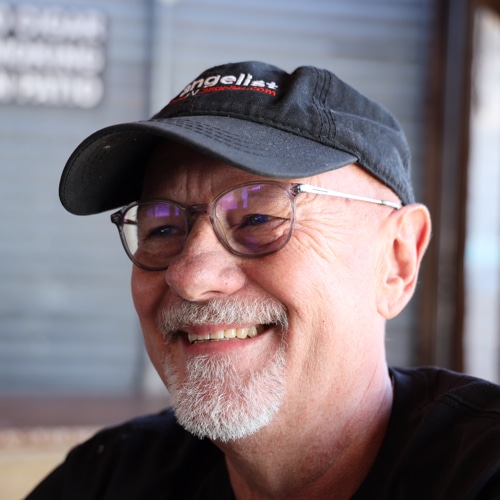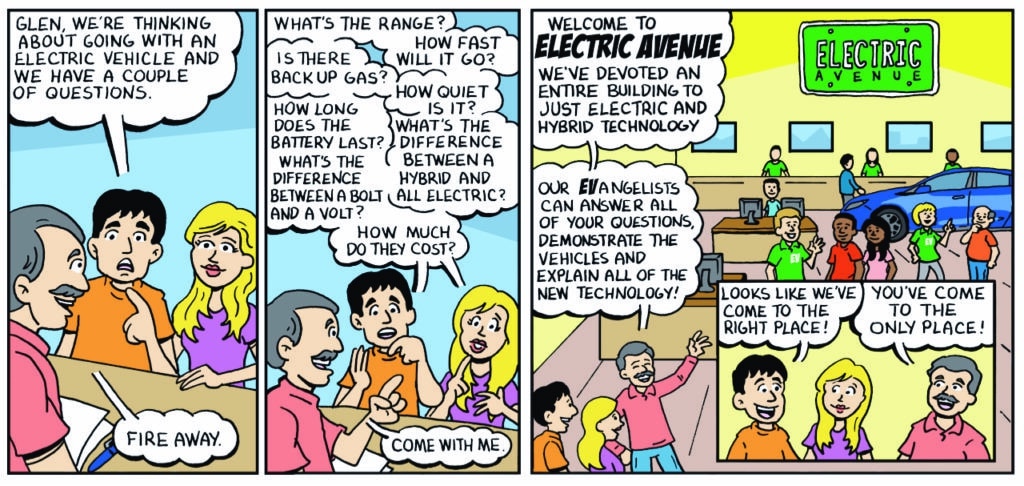A Conversation With Buzz Smith, “The EV-angelist”
Buzz Smith, “The EV-angelist”, was interviewed by Bill Pierce, Publisher, EVinfo.net. In this interview, Smith shares information about his organization, as well as his own personal EV adoption story.
BP: Tell us a little about yourself and why you call yourself the EV-angelist.
Buzz: When I got my first plug-in vehicle, I found no one, not even the auto salesperson, could answer the questions I had. I decided I should start writing about my experiences so people could decide if an EV or PHEV would be a good choice to meet their needs. I started my blog, theev-angelist.com, and called myself “The EV-angelist,” because I was spreading the “Good News” of EVs, instead of focusing on the negatives of climate change. My YouTube channel is @TheEVangelistBuzzSmith.

BP: When and why did you begin driving EVs?
Buzz: In 2012, I was working at Apple and one day, during my commute, the entire freeway came to a stop. A fracking fluids truck had flipped over. As I sat there, I saw a large SUV heading right at me. The driver was obviously playing with his smartphone and had not realized traffic had stopped. My car was totaled but I was unscathed. Gas was $4.50 a gallon back then, so after a short search for a new car, my wife suggested we look at an EV to save on fuel costs. I test drove a Nissan Leaf and almost bought it, but the range was barely enough for my daily commute and any battery degradation would have made it impractical. My next test drive was a Chevy Volt plug-in hybrid. I leased one and less than sixty days later, my wife leased one as well.
BP: Which EVs have you owned? What have been your most favorite and least favorite features of them?
Buzz: We’ve had six Chevy Volt plug-in hybrids, three leases and three purchases. Now that 250 miles of electric range is becoming common in new EVs, and my last lease has ended, we’ll get a BEV for our next vehicle. My favorite features are EV acceleration, handling and the low cost of refueling and maintenance. That being said, a PHEV was the perfect vehicle for us to use to transition to fully electric driving. I thought of my Volt as “training wheels for the EV lifestyle.” My least favorite feature? I can’t think of one, other than that the manufacturers (other than Tesla) seemed to be intentionally making EVs ugly looking. That’s finally being fixed.
BP: How have you promoted EV adoption in the past?
Buzz: I started with the blog, then started attending local government meetings about EVs, attending EV-related presentations and just telling everyone I knew what great fun my Volts were and how much money they were saving me. About a year into PHEV ownership, I asked my salesperson what the dealership was doing for National Plug-in Day (now, National Drive Electric Week, sponsored by Plug In America, Electric Vehicle Association and Sierra Club ). He didn’t know what I was talking about, so I told him that they’d have lots of EV-curious people visiting the dealership on that day. I suggested they should recruit their Volt customers to come to the dealership to tell people about their experiences. Instead, the dealership management invited me to speak at their weekly sales meeting about why I thought the Volt was critical to the future of GM and why EVs were critical for our country and the automotive industry.

Three days later, I became an auto salesperson, focused on EV and PHEV sales. Since they’d never had anyone in that role before, my manager asked me what title I wanted on my business cards. I became their first “EV-angelist.” After about a year on staff at the dealership, it occurred to me that migrating someone from gasoline to electricity was exactly like migrating Windows PC users to Macs. I pitched the idea of an “Apple Store-like environment” to the owner of the dealership and he remodeled an entire building for EV sales, with an environment built around learning instead of selling or closing. We called it “Electric Avenue,” and our store became the number one dealership for EV/PHEV sales in Texas for six years.


BP: What plans do you have for promoting EV adoption in the future?
Buzz: I “retired” in 2020 to promote EVs full time. Now I work auto show EV displays, conventions, perform public speaking and have a YouTube channel focused on EV adoption. I also teach dealerships how to sell EVs. I became board member with the Texas Electric Transportation Resources Alliance (txetra.org) to work with the state legislature on EV adoption, infrastructure rollout and taxation policy.
BP: What are the biggest barriers to EV adoption in your opinion?
Buzz: Misinformation, both unintentional and intentional as well as too much focus on climate change and the environment.
BP: How could these barriers be overcome?
Buzz: The misinformation is an ongoing battle on social media. We EV enthusiasts grow tired of fighting the same old lies we fought ten years ago, but that’s the way it is. We have to expose it every time it springs up, so it doesn’t influence people against EV evaluation. Some of the resistance is from people who make their living in the oil & gas industry. I understand that. I started my career with a ten year stint in oil and gas and lost my job (and my home) during the “bust” in the mid-1980s. Other objections are based on our crappy political environment. We are so split, as a country, that some people immediately stop listening to your EV pitch if you mention climate change, because that’s a “liberal plot.”
BP: What do you believe the government could do to promote EV adoption that they are not currently doing?
Buzz: First, the politicians can stop politicizing environmental issues. Back in the 1970s, Nixon (a Republican) signed the Clean Air Act and Clean Water Act. Grant (a Republican) established the first national park. Theodore Roosevelt (a Republican) added five more. This is NOT a liberal vs. conservative issue! Proactive steps the government needs to take now are: 1) ask EV drivers where to install the EV chargers funded through the infrastructure bill (because we have the experience), 2) start creating career retraining programs to prepare our workforce for the disruption the switch to EVs will bring and 3) focus their messaging on international competition, jobs and the importance of having a strong manufacturing base. Just like the advent of the Internet, EVs will create whole new supporting industries we can’t even imagine today. We’ll need people ready to go to work in those industries.
BP: Do you have any special programs to promote EV adoption?
Buzz: Yes. I promote “ride and drive” events, hosted by large employers. Nothing gets a person wanting an EV quite like driving one, when accompanied by an EV-experienced driver! My dealership training program is focused on salespeople learning the information EV buyers desperately need and management creating an environment that is EV-friendly. Beyond that, I’ve been working to get dealers, electric utilities, governmental organizations and charger manufacturers to join forces (and pool funding) to educate the public, reducing the workload of EV salespeople.
BP: How could middle class and lower income families be assisted in adopting EVs?
Buzz: EVs have the reputation of being a rich, white person’s indulgence. The benefits of EV adoption, for those of lesser means, are huge. First, lower income areas usually have higher air pollution and respiratory issues, because they’re usually located near heavy industry and freeways. EV adoption could help those people breathe! The low cost of electricity, coupled with very low maintenance costs, means EV drivers save tons of money. The preowned market for EVs is booming and even the early EVs can meet the needs of the vast majority of American commuters today.
Beyond that, we MUST rethink our EV incentives. The income tax credit is useless, if you’re of lower income, because you have to have $7,500 in taxes before you can use the full tax credit. It also created a needless barrier to financing. If you live in Texas, which benefits from the $7,500 federal tax credit as well as an additional $2,500 rebate, that $45K EV will actually only cost $35K. However, you still have to qualify for $45K financing, since the government funds aren’t applied at the time of purchase. You get that money later. This program has the added problem of penalizing the American manufacturers who pioneered EVs and PHEVs (Tesla and General Motors) by capping the tax credit at 200K vehicles per manufacturer. Foreign manufacturers took a wait-and-see attitude while Tesla and GM created a new industry. Now that Tesla and GM customers can no longer benefit from the tax credit, those foreign manufacturers have a $7,500 pricing advantage.
BP: Thanks Buzz Smith for taking the time to speak with us. We greatly appreciate your efforts in EV adoption and your time.

Electric Vehicle Marketing Consultant, Writer and Editor. Publisher EVinfo.net.
Portfolio: BillPierce.net
